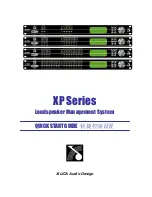
FireFinder
™
Installation Commissioning & Operation
Page 50
7.
The agent release indicator on the ACC at the FACP and LCSs is illuminated when the pressure
switch input on the termination board is activated or, immediately depending on how the pressure
switch is configured – refer to FACP on-site programming).
8.
Gas-fired relay output is activated.
9.
When the FACP reset control is activated – the manual activation indicator, agent discharge
indicator, stage 2 timer running are extinguished, and the stage 1, stage 2, selected activation circuit
and gas fired output are switched off (to 0VDC).
☞
Note:
The Interlock Input can be defaulted to the on position by placing a 10K
Ω
EOL termination
resistor across the terminals TB2. 7 / 8 of the Agent Release Module and Local Control Station.
If the agent select button is operated at the ACC once the agent has been released, then the newly
selected activation circuit is operated immediately.
The manual release facility will cause the release of the agent unless there is a fault on the activation
circuit, the lock-off valve has been operated or the service inhibit control is active.
If the lock-off valve or service inhibit is activated to the ON position during the sequence, then the
sequence is aborted. This means the manual activation indicators at the ACC and LCSs are extinguished,
the Stage 1 and Stage 2 outputs are switched OFF and the FACP Bell, ASE, Warning System, Plant and
Alarm outputs are switched OFF. The system inoperative output shall turn on.
If the lock-off valve or the service inhibit is operated after the agent has been released then there is no
effect on the stage 1 and stage 2 outputs and the selected activation circuit. The system inoperative output
shall be activated.
Auto Mode
Automatic release is when one or two zones going into alarm initiate the agent release sequence.
☞
Note:
For an automatic release sequence to commence the lock-off valve and the service inhibit
switch must both be in the OFF position.
Single Zone Activation
With single zone activation, when the zone goes into alarm, then the following release sequence is
executed:
1.
A
utomatic activation LED is illuminated on the ACC and LCSs
2.
Stage 1 output is switched to +24VDC, and the stage 1 relay output is closed
3.
Stage 2 output is switched to +24VDC, and the stage 2 relay output is closed
4.
Optional pre-release delay is commenced (Selected via FACP on-site programming – refer to
relevant FACP Manual) and the stage 2 timer indicator is illuminated.
5.
Upon expiration of the delay, and the interlock signal is turned on, and the selected activation circuit
is activated. If the interlock is in fault, then the agent will be released if the interlock signal is not
asserted within 10 seconds.
6.
The agent release LED on the ACC and LCSs is illuminated when the pressure switch input on the
termination card is activated or immediately depending on how the pressure switch configured –
refer to FACP on-site programming).
7.
The gas-fired relay output is activated.
8.
When the FACP reset control is activated – the automatic activation indicator, agent discharge
indicator, stage 2 timer running are extinguished, and the stage 1, stage 2, selected activation circuit
and gas fired output are switched off (to 0VDC).
If the agent select button is operated at the ACC once the agent has been released, then the newly
selected activation circuit is operated immediately.
The interlock input can be defaulted to the ON position by an appropriate termination resistor.
Summary of Contents for SP Series
Page 2: ......
Page 110: ...FireFinder Installation Commissioning Operation Page 104 Notes ...
Page 111: ......
















































